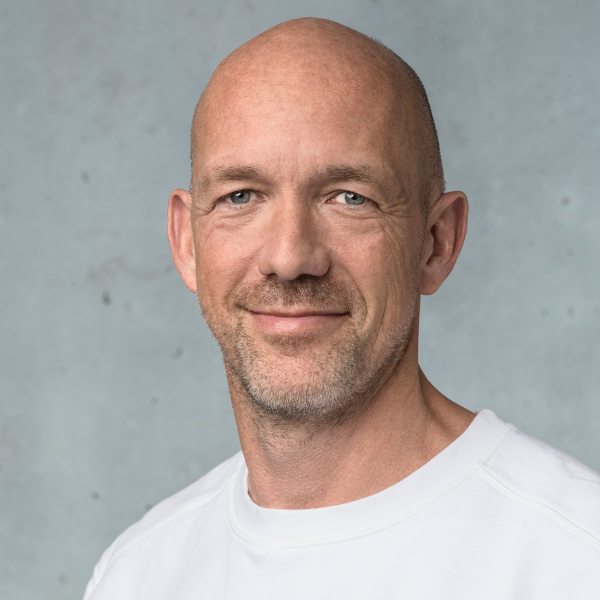
How can large organizations retain the benefits of size while also making room for internal disruption? In this episode of the FRICTION podcast, Stanford Professor Bob Sutton sits down with Michael Arena, Head of Talent at General Motors, to talk about how companies like GM can adopt new practices and become more agile. Be on the lookout for these key takeaways:
- Challenge the status quo by bringing fresh solutions to the table.
- Create an environment where new ideas are able to flow freely throughout your organization.
- Don’t shove your ideas on people; instead, let your ideas inspire others to push for change.
Check out the full episode transcript below, and subscribe on iTunes or Stitcher.
Bob Sutton: Hi, I’m Bob Sutton. I’m an organizational psychologist and Stanford professor. And this is the Friction Podcast. On today’s episode, we’re joined by Michael Arena. He’s the Chief Talent Officer for General Motors, a coach at the Stanford d.school, and author of a new book called Adaptive Space: How GM and Other Companies are Positively Disrupting Themselves and Transforming into Agile Organizations. Michael’s book ships June 15th, so it’s coming out just about now. We invited Michael to the podcast because of his work helping teams to embrace creativity and innovation in large organizations. Michael encourages employees to build networks that will spread excitement around novel ideas and challenge the status quo.
Michael Arena: Challengers break through the current status quo. Challengers frankly see a different set of possibilities. Challengers can sometimes be brokers, because they have an outside-in preview. They can see what’s coming over the horizon, but they need to find a way to be able to convey that inside of an organization in such a way that there’s a sense of urgency. So they do break down insularity, but they also really push people. They challenge people to think differently. You know, there are brick walls built up inside of large complex organizations everywhere, and what a challenger does is they help break down the brick wall or pull other people through, other people’s ideas through the brick wall so that it can become the new big idea.
Bob: Tell us the Chuck House story. I think our listeners will like it.
Michael: This is a story, you know, so Chuck House had created a display monitor that he loved. He had created it on his own, and you know, had worked on it for awhile, and he presented it, you know, in some way he, David Packard, I’m not quite sure how, but David Packard found out you know, that this monitor had been created, and he basically you know, commanded Chuck House to shut this thing down. And you know, I would say that, you know, Chuck House was irreverent in response. He sort of went underground with this idea, and he decided that he believed enough in it that he was going to go validate it in the market and talk to customers about it, you know, in his own spare time, and he got so charged up about the response from customers that he ended up, you know, building his own network inside HP in order to sort of create you know, the network buzz necessary to get the R&D group and others to buy into this idea, and somehow it came back around to David Packard and the part of the story that I love is that he was actually given an award, a medal, you know, the Extraordinary Contempt for Defiance is what it was called.
Bob: Right.
Michael: And I love that, I just love that story because you know, it illustrates that you know, leaders don’t always know.
Bob: Right.
Michael: Right, leaders don’t always know what will resonate with the market, with the network, with the consumer, and I think that’s a great illustration of a leader who recognized that you know, they may have been wrong in the beginning, and in the end, they came back around to really recognize the individual, and I think that sends a strong message to the broader organization in a symbolic way for others to be able to do the same.
Bob: And the other thing I think about that is Chuck felt like he had enough psychological safety that he could go ahead and do it anyway, and the other thing, you talk about pressure, he was really determined to make that thing great so that you couldn’t refuse it, so both the pressure and the safety, the combination of the two, I think is just a great example of it. So tell us more about these challengers. First of all, let’s talk about how you make it safe for them to succeed, and then how do you tell the difference between the ones who are constructive challengers and ones who are just kinda nuts and are gonna screw things up for everyone?
Michael: You know, the real challengers bring solutions. The real challengers don’t just challenge you know, the current status quo, and complain and whine about it. They bring solutions to the party as well, or they at least bring initial solutions that need to be iterated on, where I think the others, you know, usually whine and complain about the system and go on what I call a system rampage.
Bob: Uh-huh.
Michael: But they rarely do anything about you know, testing and iterating that idea in response to the pressures in such a way that it can be, you know, a greater organizational fit can be created. Jeff Bezos, one of my favorite quotes from Bezos is that you know, you have to be willing to be misunderstood if you’re going to innovate. A challenger is in it for the long view. A challenger sees opportunities in the marketplace, and they’re relentless about pursuing those ideas, even when they hit dead-ends from time to time, and they’re relentless about you know, helping and you know, nurturing relationships to pull other people through brick walls.
Bob: They not only tell you why the current whatever, the current culture, the current technology, is not good for us, they actually come up with a solution and do the work to grind it out, to get it in the marketplace, and to prove they’re right. So, I think that’s a really important distinction between just somebody who whines and complains and tries to tear everything down versus trying to replace it with someone else, and I think that’s an important difference for all the deviants out there who want to be successful. Let’s think of sort of the sweep of your career. When you start thinking about situations you’re in where there’s bad, dysfunctional friction, what images and emotions come to mind? What is it to you?
Michael: Living inside of a large organization is a challenge. You know, organizations are designed to drive scale and efficiency, and sometimes that’s against what individual people’s interests and ideas are, so I hear that frustration quite frequently, and I look at it as, you used the word friction, Bob, and I think of that as tension and pressure in regards to you know, it’s healthy. You know, that’s healthy attention. It’s healthy attention that causes and challenges us to think differently, to grow, and to learn.
Bob: So to me that’s constructive friction, and we’ll talk about that a lot. In fact, to me, your book is much about constructive friction. What does it look like when it’s the kind of friction that isn’t healthy and you’ve got to do something to dampen it down?
Michael: I call that stifling. You know whenever those tensions are so strong, whenever those systems and pressures are so strong that they outweigh any growth or any creativity, then what you get is a stifling effect, and that stifling strangles out creativity and growth, and agility, so we’ve got to be super careful about how much tension is enough tension. I think of it a little bit like the edge of chaos. You kinda surf this edge where you’ve got this healthy tension, friction, and if you over-index on either side you either don’t get enough growth or you get stifling.
Bob: So I just love that because it’s this idea of constantly having to do this balancing act between frustration and making things sort of too easy, and not being challenged enough. So when you think of using disruption, and Silicon Valley entrepreneurship, we’re part of the Stanford Technology Ventures Program, there’s a lot of good things about startups, but when you think about a large company like General Motors and you’ve worked for other large companies as well, what’s the stuff that doesn’t work, and if you bring it into a large organization like General Motors, it sounds good but it doesn’t actually help?
Michael: Yeah, so we presume that large, complex organizations are meritocracies and that the best ideas will rise to the top, and in a socio-political entity, that’s not always the case.
Bob: Right.
Michael: And the fact they’ve been designed, you know, in many cases to be insular, and to execute, and to operate with precision, we no longer live in the one size fits all solution space. And I think organizations now need to be much more bi-modal. Organizations now need to think, you know, from an agility standpoint, much like a startup would, but they also need to leverage the core assets that they have and being able to scale.
Bob: When you think of a large company like General Motors or other ones, so what does agility look like in that context?
Michael: I don’t know that large organizations can be agile like small organizations, but I think they can be agile on the edges. So I think of it a lot as a metaphor. You know, I think that large organizations need to be both super tankers and speedboats in the same moment. A friend of mine describes it as you need to be super fast on the edges, but you need to have the skill in the center, in the core. So mostly organizations have grown up trying to optimize human capital, you know, the experiences, the expertise that you have, you know, maybe you know, the education that you bring, the knowledge that you bring into an organization, or develop while you’re inside of an organization. And it’s critically important to organizational success. I believe we’re, you know, graduating into an era where human capital must be accentuated with social capital. So the best way to think about it is you know, if you are a super smart person, and we all know these people, right? You’re really brilliant, and you need to let everybody in the room know that you’re brilliant, your network begins to marginalize you, and you will be ill-positioned to be able to leverage what you know, and we spend all this time, money, and effort on the best, smartest, brightest talent, but we spend very, very little time thinking about how do we get that talent positioned to be leveraged. And you see this all the time. I mean, you see this in you know, some of the knowledge areas like you know, somebody who is a scientist, a you know, machine learning scientist or someone like that. You know, what they know is critically important, but the ability for them to be able to get that pulled into the network is equally as important, where I might rather take somebody that knows less, but is better positioned in the network to be able to leverage what they know. I might place that bet over the smartest person, and I think that’s what social capital is, so I think of those little speedboats and the big super tankers, and it’s the network that keeps them bound together.
Bob: Ah.
Michael: And those network ties need to reconfigure at different stages of development and maturation so you can almost think of it as if there are lifelines between these little boats and the super tanker, and sometimes they’re given more freedom to go out and explore, and other times they’re being pulled back in to be the next new big thing, you know? And it starts with, you know, if you want new ideas in an organization, if you want to trigger new ideas, as Ron Burt would say, you need to have brokerage connections. Brokers actually have, you know, unique abilities into an organization. You know, they have early access to new information, they have access to diverse sets of information, and they have control over the diffusion and sort of dispersion of that information. I call those discovery connections. That’s where ideas come from. You know, we have talked, in the network literature we’ve talked for years that ideas are sparked at the edges of the network.
Bob: Right.
Michael: And that’s what discovery’s all about. There are times where we need to get outside of our insular, you know, fortified walls inside of a large organization and we need to get more connectivity to the market. So some literature out there says that you know, ideas developed inside small teams are 43% more likely to be rejected by the larger organization, and we know this, right? I mean, it’s the not invented here mentality. They aren’t my ideas.
Bob: Right.
Michael: And even when you get endorsement, when times get tough, you know, that endorsement wanes. So I think the real, you know, I would say the newest concept in the book is this whole concept of diffusion. You know, now let’s go back to our little you know, fast speedboats. Diffusion is pulling the boats in closer and closer to the tankers as they’ve grown in scale and have graduated to even bigger speedboats, and pulling them back in to where they can become the new core, and that’s hard. That’s the tricky part.
Bob: Boy, that’s hard.
Michael: And this is where, you know, I think that incubators and accelerators are sometimes problematic. You know, if you can’t pull it back in, then you can’t really get the scale and the benefit of a large, complex organization. I think it’s Ron Burt who once said that if your network’s not talking about you, you don’t exist.
Bob: Right.
Michael: And it’s a little bit of that, right? If the network’s not talking about your idea, it doesn’t exist, so the trick is to get your network talking about the idea, and the best way to do that is to enlist the network, not push it upon the network.
Bob: What you’re making me think of, it’s one of our mutual friends, David Kelley, who is the primary founder of the Stanford d.school, and the primary founder of IDEO, and I’ve seen him in action now for more than 20 years, and as I think about David, David probably is not the best person at developing a product, or even finding the ideas, but he’s the best person I have ever met at taking the idea and just getting people excited about it.
Michael: You know, you can’t force this upon people, so you’ve gotta create sort of this free trade zone where people can come together, so we do something here that we call tipping forward. It’s almost like an idea bazaar, where once a year we have like this living museum of different ideas that have been developed, and then what we do is we bring in energizers, and this gets a little bit back to your point about David, and I’ve been in the room with him.
Bob: Oh, it’s incredible.
Michael: And you feel his energy, and you just feel like you’re part of something bigger than yourself when you’re in the room with these energizers. And both Ron and Wayne, their work says that these energizers have a four X lift on getting ideas spread.
Bob: So to create an adaptive space, what are some of the key environmental conditions that you need?
Michael: You know, so first of all, it’s the freedom and the flow of new ideas into and throughout the organization. Oftentimes that doesn’t happen inside of large organizations. There are lots of tools that you can use to open up adaptive space, and adaptive positive deviances is one of my favorite. It’s let’s go find where it’s already happening today. Let’s study an existing pocket where something brilliant is happening today, and how do we discover that?
Bob: Yeah, you actually used a really interesting story about a practice that was used to stop MRSA, which is an infection that spreads throughout hospitals.
Michael: Yes, it was Einstein Medical Center in Philadelphia that was you know, studying this issue, and you know, as they were engaging in this concept of adaptive positive deviance, and they started asking themselves the question, you know, okay, so where is it a problem, where is it less of a problem? And one of the nurses, you know, first of all they discovered one area inside the hospital where it wasn’t as significant of a problem, and one of the nurses knew a little bit about that area. She had remembered that this janitor inside that particular wing was sharing with her and the rest of the nurses a degowning practice that he had created for himself. His name was Jasper Plummer, and Jasper had you know, basically helped to convince the nurses inside of this one area of the hospital that you know, if they degowned in a specific way, that it would actually help him, and he taught them a degowning practice where they would literally pull them from the outside in, with gloves on, and then ultimately, you know, ball them up inside of a glove and pull the glove onto their hand while the glove is containing the whole gown that they had just pulled off. Well, it turns out that what was also being contained inside that glove was the MRSA, and it just, it became a positive deviant practice where he inadvertently created a solution to a major problem inside of this hospital that was then shared you know, across the broader hospital.
Bob: So to me that’s a really interesting story, and it sort of, I had a conversation a few years back with Toby Cosgrove, who was CEO of the Cleveland Clinic, quite a famous CEO, and I asked him about, ’cause all hospitals are sort of battling this notion of infections that you get in the hospital, and he said well, the difference between the good and the bad healthcare systems is that the good healthcare systems figure out what the best units do and spread it, and the bad ones treat the ones who have good MRSA numbers and the like, as sort of like the enemy who you know, are performing above them, so to me that’s a real important sort of mindset. Our guest today, Michael Arena, is the Chief Talent Officer of General Motors, and he’s author of a new book called Adaptive Space: How GM and Other Companies are Positively Disrupting Themselves and Transforming into Agile Organizations. Thank you so much, Michael.
Michael: Thank you, Bob, I enjoyed it.







